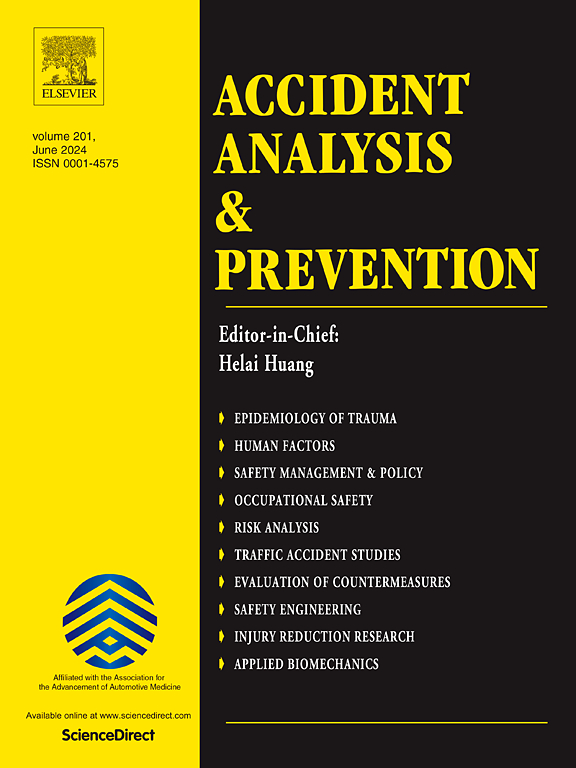Exploring the Mechanism for Increased Risk in Freeway Tunnel Approach Zones: A Perspective on Temporal-spatial Evolution of Driving Predictions, Tasks, and Behaviors
IF 5.7
1区 工程技术
Q1 ERGONOMICS
引用次数: 0
Abstract
Freeway tunnel approach zones, situated outside the tunnel, do not undergo the same sudden changes in luminous environment and visual references that entrance zones experience. Despite this, accident data indicates that approach zones present similar safety risks to entrance zones, both of which are significantly higher than other tunnel sections. The reasons for the heightened risks in approach zones remain unclear in existing research. To address this knowledge gap, this study conducted real vehicle tests and subjective perception experiments. The Task Analysis of Driving Scenarios (TADS) was employed to analyze driving behavior patterns and develop a set of evaluation metrics, including four key driving behavior nodes (P1_SGD, P2_EF, P3_FF, P4_SAD), safety and efficacy indices for active deceleration behaviors (I1_ADS, I2_ADE), and two indicators for understanding anomalous behaviors (SR, AOI_PFN). By skillfully selecting scenarios to control variables, this research examined how limited visibility in tunnel approach zones and spatial intervisibility tunnels contribute to safety risks in these zones. Additionally, the Predictive Processing Model (PPM) was used to elucidate the temporal and spatial evolution of driving predictions, tasks, and behaviors under normal conditions. The findings reveal that, although heavy driving tasks cannot be avoided, under normal conditions, predictions develop gradually with minimal prediction errors, enabling effective navigation. However, limited visibility in tunnel approach zones and spatially intervisible tunnels lead to inaccuracies and deviations in predictions, resulting in significant prediction errors as drivers approach the tunnel. This causes more aggressive driving behaviors, disrupting the delicate balance of predictions and tasks.
探索高速公路隧道引线区风险增加的机制:驾驶预测、任务和行为的时空演化视角。
高速公路隧道入口区域位于隧道外部,不像入口区域那样经历光照环境和视觉参考的突然变化。尽管如此,事故数据表明,引路区与入口区存在相似的安全风险,两者都明显高于其他隧道段。在现有的研究中,接近区风险增加的原因尚不清楚。为了解决这一知识差距,本研究进行了真实车辆测试和主观感知实验。采用驾驶场景任务分析(TADS)对驾驶行为模式进行分析,并建立了一套评价指标,包括4个关键驾驶行为节点(P1_SGD、P2_EF、P3_FF、P4_SAD)、主动减速行为的安全性和有效性指标(I1_ADS、I2_ADE)以及理解异常行为的2个指标(SR、AOI_PFN)。通过巧妙地选择场景来控制变量,本研究考察了隧道引道区域的有限能见度和隧道的空间互视性对这些区域的安全风险的影响。此外,预测处理模型(PPM)用于阐明在正常条件下驱动预测、任务和行为的时空演变。研究结果表明,尽管繁重的驾驶任务无法避免,但在正常情况下,预测会逐渐发展,预测误差最小,从而实现有效的导航。然而,由于隧道接近区能见度有限,隧道在空间上不可见,导致预测不准确和偏差,导致司机接近隧道时的预测误差很大。这会导致更激进的驾驶行为,破坏预测和任务之间的微妙平衡。
本文章由计算机程序翻译,如有差异,请以英文原文为准。
求助全文
约1分钟内获得全文
求助全文
来源期刊

Accident; analysis and prevention
Multiple-
CiteScore
11.90
自引率
16.90%
发文量
264
审稿时长
48 days
期刊介绍:
Accident Analysis & Prevention provides wide coverage of the general areas relating to accidental injury and damage, including the pre-injury and immediate post-injury phases. Published papers deal with medical, legal, economic, educational, behavioral, theoretical or empirical aspects of transportation accidents, as well as with accidents at other sites. Selected topics within the scope of the Journal may include: studies of human, environmental and vehicular factors influencing the occurrence, type and severity of accidents and injury; the design, implementation and evaluation of countermeasures; biomechanics of impact and human tolerance limits to injury; modelling and statistical analysis of accident data; policy, planning and decision-making in safety.
 求助内容:
求助内容: 应助结果提醒方式:
应助结果提醒方式:


